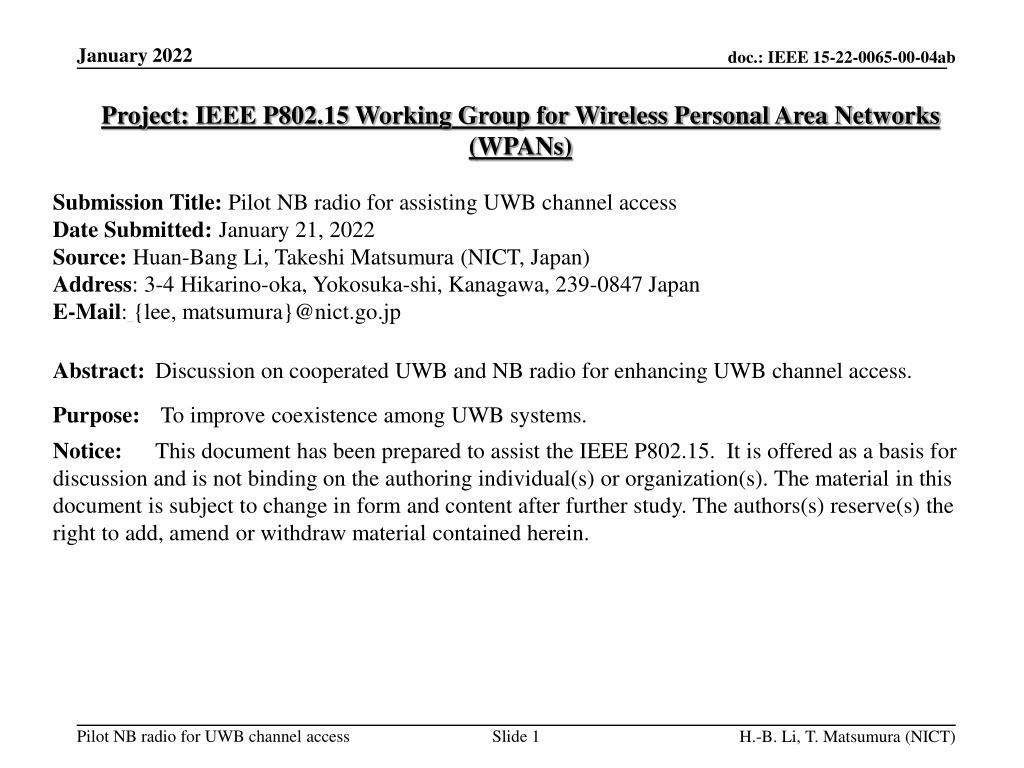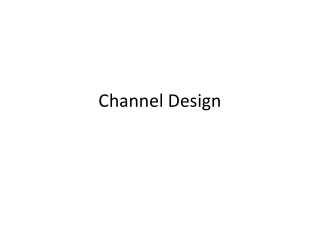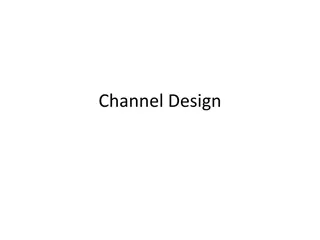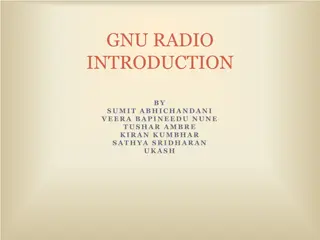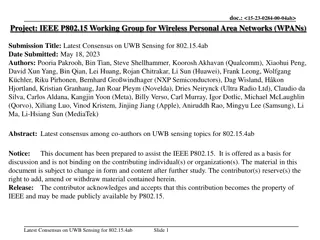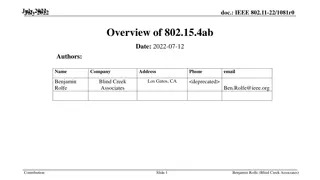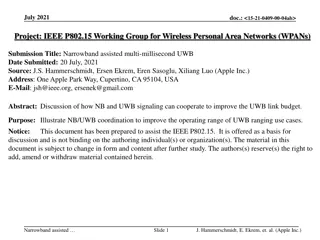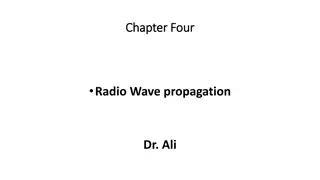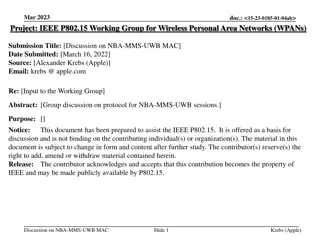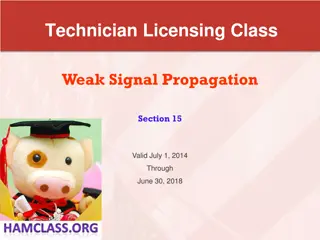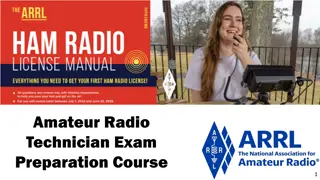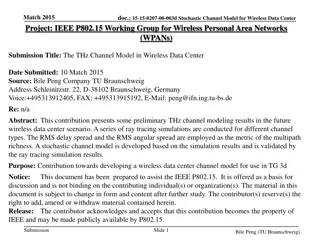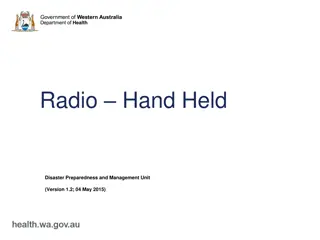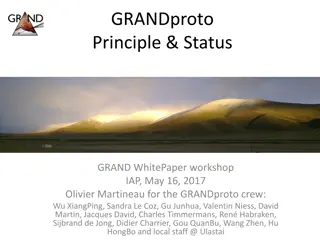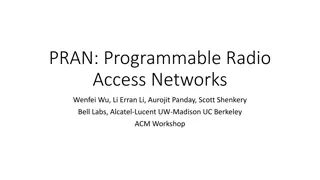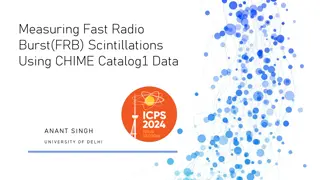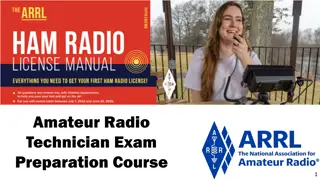Enhancing UWB Channel Access with Pilot NB Radio
Discussion on cooperative use of UWB and NB radio technologies to enhance UWB channel access, aiming to improve coexistence among UWB systems. The proposal includes utilizing a pilot NB radio to facilitate Clear Channel Assessment (CCA) for better coexistence, backward compatibility with enhanced ranging devices, improved link budget, additional channels and frequencies, enhanced accuracy, reduced complexity, and more.
Download Presentation

Please find below an Image/Link to download the presentation.
The content on the website is provided AS IS for your information and personal use only. It may not be sold, licensed, or shared on other websites without obtaining consent from the author.If you encounter any issues during the download, it is possible that the publisher has removed the file from their server.
You are allowed to download the files provided on this website for personal or commercial use, subject to the condition that they are used lawfully. All files are the property of their respective owners.
The content on the website is provided AS IS for your information and personal use only. It may not be sold, licensed, or shared on other websites without obtaining consent from the author.
E N D
Presentation Transcript
January 2022 doc.: IEEE 15-22-0065-00-04ab Project: IEEE P802.15 Working Group for Wireless Personal Area Networks (WPANs) Submission Title: Pilot NB radio for assisting UWB channel access Date Submitted: January 21, 2022 Source: Huan-Bang Li, Takeshi Matsumura (NICT, Japan) Address: 3-4 Hikarino-oka, Yokosuka-shi, Kanagawa, 239-0847 Japan E-Mail: {lee, matsumura}@nict.go.jp Abstract: Discussion on cooperated UWB and NB radio for enhancing UWB channel access. Purpose: To improve coexistence among UWB systems. Notice: This document has been prepared to assist the IEEE P802.15. It is offered as a basis for discussion and is not binding on the authoring individual(s) or organization(s). The material in this document is subject to change in form and content after further study. The authors(s) reserve(s) the right to add, amend or withdraw material contained herein. Pilot NB radio for UWB channel access Slide 1 H.-B. Li, T. Matsumura (NICT)
January 2022 doc.: IEEE 15-22-0065-00-04ab PAR Objective Safeguards so that the high throughput data use cases will not cause significant disruption to low duty-cycle ranging use cases Interference mitigation techniques to support higher density and higher traffic use cases Other coexistence improvement Proposed Solution (how addressed) Effective and efficient CCA reduce disruption between UWB devices Use pilot NB radio as pilot to facilitate CCA so as to improve coexistence. Use pilot NB radio to improve coexistence among UWB devices. Backward compatibility with enhanced ranging capable devices (ERDEVs) Improved link budget and/or reduced air-time Additional channels and operating frequencies Improvements to accuracy / precision / reliability and interoperability for high-integrity ranging Reduced complexity and power consumption Hybrid operation with narrowband signaling to assist UWB Exploiting pilot NB PHY and concurrent operation with UWB to assist UWB channel access Enhanced native discovery and connection setup mechanisms Sensing capabilities to support presence detection and environment mapping Low-power low-latency streaming Higher data-rate streaming allowing at least 50 Mbit/s of throughput Support for peer-to-peer, peer-to-multi-peer, and station-to- infrastructure protocols Infrastructure synchronization mechanisms Pilot NB radio for UWB channel access Slide 2 H.-B. Li, T. Matsumura (NICT)
January 2022 doc.: IEEE 15-22-0065-00-04ab Contents 1. Pilot NB radio for assisting UWB channel access FCP and PCP Features 2. Consideration of pilot narrow band radio 3. Use of sub-GHz spectrum in Japan Rules on using the sub-GHz Candidate spectrum Examples of usage and benefits 4. Conclusion Pilot NB radio for UWB channel access Slide 3 H.-B. Li, T. Matsumura (NICT)
January 2022 doc.: IEEE 15-22-0065-00-04ab Pilot NB radio for assisting UWB channel access According to 802.15.4-2020, a compliant UWB PHY is required to perform CCA when accessing UWB channels with one of the following six CCA modes. CCA Mode 1: Energy above threshold. CCA Mode 2: Carrier sense only. CCA Mode 3: Carrier sense with energy above threshold. CCA Mode 4: ALOHA. CCA Mode 5: HRP UWB preamble sense based on the SHR of a frame. CCA Mode 6: HRP UWB preamble sense based on the packet with the multiplexed preamble as specified in 15.6. We proposed to add an additional CCA mode to the above CCA Mode #: Pilot NB radio assisted channel sensing. how the multiple devices to coordinate when sensing the channel and possible fairness issues Pilot NB radio for UWB channel access Slide 4 H.-B. Li, T. Matsumura (NICT)
January 2022 doc.: IEEE 15-22-0065-00-04ab Two Realizations CCA CCA CCA Pilot NB Start and stop of transmission are fully synchronized. Pilot NB Pilot NB TX signal UWB task UWB task UWB task time #1 Fully concurrent pilot (FCP) Pilot NB Pilot NB Pilot NB Pilot NB signal is of short length and is used as an indicator. TX signal CCA CCA CCA UWB task x UWB task y UWB task z time #2 Partially concurrent pilot (PCP) Pilot NB radio for UWB channel access Slide 5 H.-B. Li, T. Matsumura (NICT)
January 2022 doc.: IEEE 15-22-0065-00-04ab Features Avoid the difficulties of sensing noise-like UWB signal. Provide unified structure and procedure that can be commonly used by different UWB schemes including HRP, LRP, 15.6. Exploit legacy sensing methods developed with NB radios and benefit from their effectiveness and efficiency, such as CCA Mode 1: Energy above threshold. CCA Mode 2: Carrier sense only. CCA Mode 3: Carrier sense with energy above threshold. No need to touch into preamble of UWB packet. (For details, please refer to 15-21-0589-00-04ab) Pilot NB radio for UWB channel access Slide 6 H.-B. Li, T. Matsumura (NICT)
January 2022 doc.: IEEE 15-22-0065-00-04ab Pilot NB radio consideration Find a proper NB spectrum Less of regulatory restriction Off-the-shelf devices/chips Provide fairness among devices for channel access From viewpoint of regulatory requirement as well as control design Coexistence between pilot NB radio and other NB radio No heavy usage and no long duration of occupancy. Pilot NB radio for UWB channel access Slide 7 H.-B. Li, T. Matsumura (NICT)
January 2022 doc.: IEEE 15-22-0065-00-04ab License-exempt sub-GHz radios in Japan TX Pilot NB radio for UWB channel access Slide 8 H.-B. Li, T. Matsumura (NICT)
January 2022 doc.: IEEE 15-22-0065-00-04ab Proper candidate spectrum for pilot NB radio 100kHz 16ch (928.15 to 929.65) #62 #63 #64 #65 #66 #67 #68 #69 #70 #71 #72 #73 #74 #75 #76 #77 Frequency (MHz) 928.15 928.25 928.35 928.45 928.55 928.65 928.75 928.85 928.95 929.05 929.15 929.25 929.35 929.45 929.55 929.65 Restriction to use the spectrum maximum TX power maximum antenna gain Channel occupation maximum TX duration TX pause duration 1mW 3 dBi Up to 5 50ms 50ms Pilot NB radio for UWB channel access Slide 9 H.-B. Li, T. Matsumura (NICT)
January 2022 doc.: IEEE 15-22-0065-00-04ab Benefits as pilot NB radio Free spectrum with less restriction. Availability of frequent channel access (every 50 ms) Up to 50ms transmission for each access Multiple available channels 16 channels enable various combinations Light expected usage with restricted TX power Active RFID Pilot NB radio for UWB channel access Slide 10 H.-B. Li, T. Matsumura (NICT)
January 2022 doc.: IEEE 15-22-0065-00-04ab Example of usage (without overlap) pttn #1 pttn #2 pttn #3 pttn #4 #62 #63 #64 #65 #66 #67 #68 #69 #70 #71 #72 #73 #74 #75 #76 #77 #71 #72 #73 #74 #75 #66 #67 #68 #69 #66 #67 #68 #69 #66 #67 #68 #69 #66 #67 #68 #69 #66 #67 #68 #69 pttn #21 pttn #22 pttn #23 pttn #24 pttn #25 w/transmit wt/transmit Pilot NB radio for UWB channel access Slide 11 H.-B. Li, T. Matsumura (NICT)
January 2022 doc.: IEEE 15-22-0065-00-04ab Example of usage (with overlap) pttn i-1 pttn i #62 #63 #64 #65 #66 #67 #68 #69 #70 #71 #72 #73 #74 #75 #76 #77 #71 #72 #74 #75 #71 #73 #74 #75 #71 #72 #73 #75 pttn i1 pttn i2 pttn i3 Pilot NB radio for UWB channel access Slide 12 H.-B. Li, T. Matsumura (NICT)
January 2022 doc.: IEEE 15-22-0065-00-04ab Improved RX power Sub GHz band UWB CH 9 Difference of RX power is 39 dB Pilot NB radio for UWB channel access Slide 13 H.-B. Li, T. Matsumura (NICT)
January 2022 doc.: IEEE 15-22-0065-00-04ab Conclusions The proposed pilot NB radio assisted UWB channel access provides a common framework that can be used by different UWB schemes. Examples of pilot NB radio using Japanese sub-GHz band is presented, which is suitable for the considered purpose with low emission power and multiple channels. Significant improvement can be achieved in the sense of RX power to be sensed. Pilot NB radio for UWB channel access Slide 14 H.-B. Li, T. Matsumura (NICT)
January 2022 doc.: IEEE 15-22-0065-00-04ab Reference Slides Pilot NB radio for UWB channel access Slide 15 H.-B. Li, T. Matsumura (NICT)
January 2022 doc.: IEEE 15-22-0065-00-04ab Mapping pilot multiple carriers Mapping multiple carriers: Form a multiple carriers group for the purpose of indicating UWB channels (MCG-ch). Each element in the MCG-ch corresponds to a single specified UWB channel. Form a multiple carriers group for the purpose of indicating UWB task durations (MCG-td). Each element in the MCG-td corresponds to a pre- determined duration to execute a UWB task. fi fj frequency Pilot NB radio for UWB channel access Slide 16 H.-B. Li, T. Matsumura (NICT)
